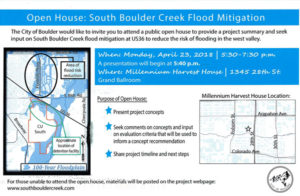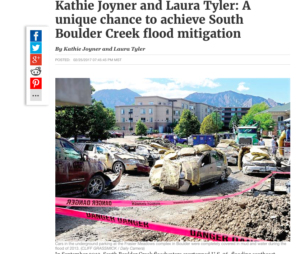If you attended the Boulder Valley Comprehensive Plan Open House on September 26th, 2016 you may recall how contentious it felt. In the days leading up to the meeting, opponents to changes at CU South posted some false and alarming notices on trails in the area which resulted in public expressions of anxiety and uncertainty about annexation and Option D. While city staffers were able to debunk some of the misinformation being spread, we believe a lot of people left the Comp. Plan Open House with unresolved questions and concerns about the purpose of annexation and CU’s long range plans for the CU South property.
In response, the University of Colorado has created this FAQ, Commonly Asked Questions about CU Boulder South. Here are a few excerpts.
I regularly use the CU Boulder South property for recreation, outdoor enjoyment and walking my dog. Will I still be able to do this when you develop the property?
Yes. Since purchasing the site we have provided the community with access to the area and that will continue. CU will maintain public access to the property, including publicly available trails and access to the city’s adjacent Open Space (where allowed by the city), parks and regional trail system regardless of what is ultimately developed on the property. In fact, the final connection for the last leg of the city’s South Boulder Creek Trail was made possible by CU providing an easement for the city to build a walkway across the wetlands.
What will CU develop on this property?
We don’t specifically know yet. Even identifying the long-term needs of the university is, in and of itself, a long-term project. All of our development projects go through a large number of review processes and we engage many stakeholders, including the community, all of which will take a significant amount of time.
We can tell you that any development at CU Boulder South would support the campus and community goals for environmental sustainability and resiliency by:
• Designing sustainable buildings to minimize or eliminate the overall carbon footprint of our facilities. All our new facilities meet USGBC’s Gold or Platinum LEED standards.
• Incorporating renewable energy sources
• Providing multimodal transportation access, minimizing automobile use with CU, regional and city bus transportation, and bicycle and pedestrian paths
• Using Xeriscape and native vegetation to conserve water
• Protecting jurisdictionally-designated wetlands and other significant environmental resources
We can also tell you what any future development might include:
• Creating floodwater mitigation areas to improve the flood safety of people, residences and
buildings downstream
• Creating low impact recreational and athletic fields which could serve shared community use
• Continuing to use the property as a training site for our cross-country track and tennis teams
• Adding restrooms and showers for athletes and restrooms and drinking fountains for attendees to sporting events
• Faculty and staff affordable, workforce housing. (We are currently conducting a survey of our staff and faculty to determine their housing needs, and whether the university might be able to develop housing to meet some of those needs.)
• Graduate student housing and/or upper division undergraduate housing incorporated into
academic villages
• Academic, instructional and research facilities
• Outdoor research spaces
We can also tell you that:
• Any development would maintain the same high aesthetic standards of other CU Boulder
properties
• The quality of CU Boulder as an institution of higher education is and will continue to be
reflected in its buildings — their quality, beauty, consistency, and permanence.
• Functional arrangement of buildings, while being mindful of preserving views, will be a defining characteristic for development of CU Boulder South
• The design of buildings will complement the existing topography and maintain sensitivity to
surrounding neighbors
• We will keep the community informed and work closely with the city as development plans
begin to emerge December 13, 2016
And here is what we can tell you that we do NOT intend to build on the site:
• A football stadium
• Towers à la Williams Village
• First-year freshman housing
• A bypass public roadway connecting Highway 93 and Highway 36
• A full build out of all 308 acres
Read the full document here: Commonly Asked Questions about CU Boulder South.


